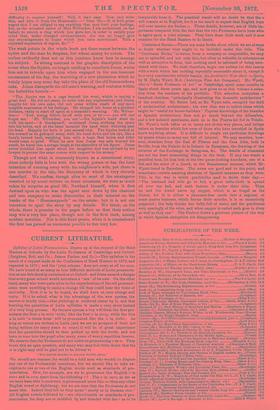CHRISTMAS BOOKS.—There are some books about which we are always
in doubt whether they ought to be included under this title. The "Christmas Books," however, form a company so respectable, we may say so splendid, and not only this, but often so valuable in substance as well as attractive in form, that nothing need be ashamed of being asso- ciated with them. We shall, therefore, begin our notices for this season with a work which has nothing especially seasonable shoat it, except it be a very considerable artistic beauty, An Architect's Note-Book in Spain, by M. Digby Wyatt, MA. (Autotype Fine Art Company). Mr. Wyatt, who is "Slade Professor of Art" at Cambridge, spent some months in Spain about three years ago, and now gives us in this volume a selec- tion from the contents of his portfolio. This selection comprises a hundred sketches, "principally illustrating the domestic architecture" of the country. Mr. Street had, as Mr. Wyatt tells, occupied the field of ecclesiastical architecture ; his own idea was to collect ideas which might be "useful for house-builders." Popular knowledge of the beauties of Spanish architecture does not go much beyond the Alhambra, and a few isolated specimens, such as is the Puerta del Sol in Toledo. Mr. Wyatt's book takes us to many out-of-the-way places, and brings before us beauties which few even of those who have travelled in Spain know anything about. It is difficult to single out particular drawings for praise where so many are full of interest. We may mention, how- ever, sketches from the Cul di Pilaus and the Casa Alba, both in Seville, from the Palacio de la Infanta in Saragossa, the drawing of the exterior of the Exchange in Saragossa, do. The details of ornament are not the least interesting things in the book. If any one wants a practical hint, let him look at the two queer-looking knockers, one of a fish and the other of a lizard, in the Renaissance manner, which Mr. Wyatt found in Barcelona. The notes are good and to the point, and sometimes contain amusing sketches of Spanish manners as they were. This is the way in which gentlefolks used to finish their day:— " The husband and wife go to bed, a great table-cloth is spread all over the bed, and each fastens it under their chin. Then he and the dwarf serve up supper, which is as frugal as the dinner, for it is either a pheasant-hen made into a ragoust, or some pastry business, which burns their months, it is so excessively peppered ; the lady drinks her belly-full of water, and the gentleman very sparingly of the wine, and when supper is ended each goes to sleep as well as they can." The Preface draws a grievous picture of the way in which Spanish antiquities are disappearing.


































 Previous page
Previous page